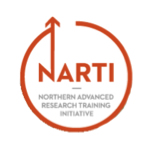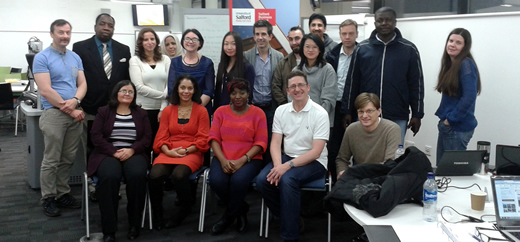 Salford Business School in collaboration with the Northern Advanced Research Training Initiative (NARTI) organised a workshop to help PhD students and academics to develop their online profiles.
Salford Business School in collaboration with the Northern Advanced Research Training Initiative (NARTI) organised a workshop to help PhD students and academics to develop their online profiles.
This hands on workshop allowed participants to review their personal academic profile strategy and plan future activities to increase their research impact.
NARTI is an association of leading research-based Universities’ Business and Management Schools in the UKs North of England of which Salford Business School is a member. NARTI hosts a number of training sessions and events to boost the research agenda in the North of England. This workshop was hosted by Salford Business School on the 26th November 2014 and was facilitated by myself – Udeni Salmon and Aleksej Heinze.
What did the participants learn as part of this NARTI workshop? Participants were asked to bring their laptops and logged into WiFi at the start of the session. Throughout the session, participants were blogging, tweeting and updating their social media profiles.
At the beginning of the session the participants were asked to document one key question that they wanted answered as part of the day. Read on to find out what the participants’ areas of interest were, and their reflections on what they learned:
Here are the main notes from the session:
Academic online profile development – NARTI Workshop – Salford Business School
1) Why develop an academic online profile?
Ayman Alhabshi wanted to know why an online academic profile was necessary. At the end of the session, the realisation was clear that having the right profile makes you more approachable to people who could be interested in your research. Ayman said,
“Being easily findable by potential research beneficiaries can save you time and effort in communicating your research to the right audiences such as potential research participants as well as those who might want to use your findings. Thinking beyond getting your research into a academic paper is increasingly important.”
For example, for the UK based academics making research impact is increasingly important and the Research Excellence Framework is looking for evidence of impact for your research. By keeping a log of your research activities on social media helps to see the impact story and evidence collection developing over time.
2) How to develop an academic online profile?
The process of developing an academic profile was of interest to Nawras Nusairat. He was able to take away with him the techniques of placing yourself into the position of the research audiences and identifying the language they might be using to find his work. This part was influenced by the keyword research and identification of relevant networks for his work. Nawras said,
“The process of developing an academic research profile involves identifying the content and individuals and engaging with these on your networks. For example, sharing your research publications and slides with the right audiences on LinkedIn, keeping a record of all your activities and potentially sharing these on social networks.”
3) How can social media help your academic career?
Kostas Chaldoupis realised that social media can help your career by connecting you with like-minded individuals around the world who are passionate about the common area of research. Networking with these individual regardless of their physical location allows you to develop your interests and eventually you can learn more in relation to your research area. Kostas said,
“Social media can contribute considerably to enhancing your employment opportunities and help you to find an academic position. Social media can be used as a tool of academic knowledge sharing and development.”
4) How can I use search engine optimisation (SEO) as a tool?
Arsim Sadiku was keen to learn more about search engine optimisation – SEO. Arsim said,
“Prior to this workshop I was only aware of the optimization as a tool to increase presence of products and online/public profiles for organisations. Today, I gained understanding of how to build a profile using SEO techniques for my personal research profile, which convinced me that it will result in better communications with the potential interested parties. Today’s session will serve as a solid starting point that remains for me to build upon in the future.”
5) What are the ethical issues in ethnography research?
Mona Nassar is researching the world of online interactions and wanted to explore ethical research techniques. Mona said,
“Before this session I didn’t know about the ethical considerations for using any published data in research (LinkedIn, blogs, Twitter etc.). Now I know that I have to make data captured online anonymous or get the approval of individual’s if I’m using their thoughts or opinions.”
6) How can I use social media to contact research participants?
There are a number of different social media channels – Twitter/LinkedIn/Facebook that could be used for developing contacts with potential research participants. A key issue is that each potential channel has different advantages and limitations. They can be more or less relevant for different types of contacts. Social networks (e.g. Facebook) can be considered as a helpful source of building a sampling framework for your research.Chris Kelsall observed that there is the potential for different social media channels to inform each other. Chris said
“It is probably safer to make all comments and discussion from a more professional perspective and so your content needs to be thought through on this basis. This may also necessitate affirmative action in terms of permission to use content in your communications. For example, it is best to ask if it is OK to use quotes/comments/web capture of statements in your research. Practising the use of the different channels will help you develop the effectiveness of your participants engagement approach.”
7) How should I separate posts on social media as personal or professional?
Social media Revolution is changing the way we engage as a society and as the above video highlights social media touches every aspect of people’s lives. Though historically, social networks such as Facebook, Twitter and LinkedIn have been perceived as a hub or interface for people’s leisure activities, they are now more used in business communication too.
Therefore for example, most recruiters are now using social media in searching or recruitment of candidates and marketers are using social media for marketing products or services.
In this case at times it is becoming difficult to separate social personal posts from professional posts, more especially for people whose careers are highly public. Charles Leyman Kachitsa learned from the workshop that the key is the choice of type of the social media used.
“As a rule of thumb social media platforms such as Facebook are more used for personal posts, while LinkedIn is used for professional posts – assuming that you have both accounts. This rule follows the Pareto principle of 20/80, meaning for instance 20% of your posts on Facebook may be professional while 80% would be personal.”
8) How do I develop a strategy for prioritising which social media platforms I use?
Robert Hayward was keen to understand how best to manage his research centre’s social media sites. Robert said:
“Rather than worrying about having to manage multiple accounts and the time investment required for this, it is better to have a ‘hub’ to upload thoughts, comments, discussions, tweets, files, etc. From that hub, you can post them to the appropriate social media platform. You need to decide which is the best ‘hub format’: it could be a blog space, it could be Twitter, it could be LinkedIn, it could also be your SlideShare profile – it all depends on your audiences and content.
It was an insightful workshop on how to use LinkedIn effectively to promote one’s self be it by joining groups or attaching one’s academic portfolio via third party platforms such as slideshare. A goodway to enhance one’s academic credentials not just by placing one’s academic CV’s.
The workshop was also instrumental in teaching the fundamentals of SEO, with emphasis on how to research keywords and implementing them in a blog post. This provided a good insight into using WordPress and SEO.”
Joseph Asamoah commented that vanity URLs in all networks were discussed, for example, using URLs on LinkedIn is also a good way to make sure that your personal identity is clearly visible to potential contacts. E.g.: https://www.linkedin.com/in/josephasamoah
9) What tools should I use to manage social media profiles?
Robert Hayward found the use of the following tools helpful to manage social media profiles:
- The use of Google AdWords keyword planner tool helps you to focus and optimise the key words to use in your profiles and posts for maximum audience coverage.
- Google Citations (in Google Scholar) is a great way to view the impact / engagement with your publications.
- Other tools such as Hoot Suite, Sprout Social or Buffer will allow you to schedule your posts and view the engagement with them.
- The final aspect is to ensure that you optimise your presence so that your keywords (your brand) is always visible e.g. your LinkedIn URL (or your hub).
10) Social media as a classroom technology?
In a digital world, technology in the classroom cannot be ignored. At this workshop Adewolu Opeoluwa summarised the five key ideas that can help boosting her potential use of social media as a classroom technology:
- Having a blogging activity at the end of the session allows participants to reflect and learn collaboratively what they took away as part of the session. This also offered a diary whilst connected to other social media to disseminate information/findings on my research. The participants logged onto the blogpost and were simultaneously editing the post which you’re reading right now.
- Allowing participants to work in groups and individually on their laptops brings flexibility to the session which is useful to develop in class interaction.
- Sharing slides with participants ahead of the session through a file sharing facility such as DropBox does not require the use of large email attachments.
- Using of URL shortness to share links during the session which would otherwise be difficult to spell due to their length.
- Developing in-class interaction such as taking images and sharing them during the session increases audience participation. Here is a photo taken from our session:

Do you have any thoughts on how to improve academic profile through social media?
Here are some tweets from the day
Sheffield Business School, Sheffield Hallam University tweet
Please do share them here!
I was at the programme. Alex and Udeni did a wonderful job. Thank you. I used the knowledge gained at the programme, to updated my profile on LinkedIn and guess what? I got all most instant feedback from some people I never know or meet before. Thank you Alex and Udeni. From Moshood Bello (PhD Researcher, Salford Business School)
Thanks for sharing your comments.
Really helpful summary of the session, thanks very much
It’s a very helpful workshop – Thank You!
Thanks for your feedback!